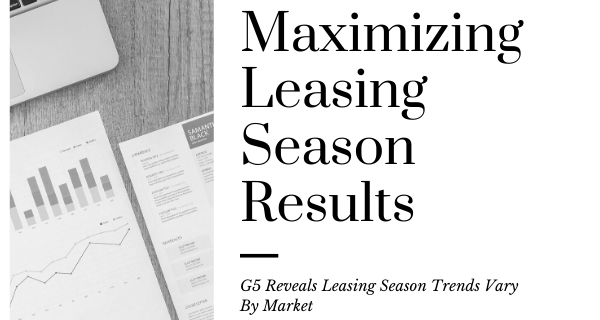
Maximizing Leasing Season Results
As a seasoned multifamily pro, you know that leasing season runs May through September. Marketers ramp up their advertising efforts to catch the wave of new renters in the summer months. Like clockwork, you know what to expect.
Leasing Seasons Vary by Market
In our 1H 2020 Multifamily State of the Industry report, we took a closer look at online search behaviors for renters across thousands of properties in the U.S. We used multi touch attribution data to evaluate interactions of all users and across multiple marketing sources to provide insight into the total renter journey. This deeper insight allowed us to understand how and when renters are ramping up their online search for a new apartment. Thus, we have an additional layer to the story told by traditional KPIs: ad impressions, clicks, and web sessions.
What we found is huge. Not only do renters’ online behaviors vary by region, but the timing of those interactions also has a big impact on leasing seasons. What we have generally called the typical leasing season is just that: general. In-market data shows more nuance.
Across all markets, the average renter’s journey is 21.9 days: from first interaction on a search to inquiry. However, in those 21.9 days, renter behavior was different in each market.
We analyzed four KPIs across three major metropolitan statistical areas – Houston, Phoenix, and Seattle. The MSAs were chosen for their geographic diversity and high-volume of existing demand. Each of the selected KPIs is significant, as it highlights a different aspect of the renter journey.
Google Ads Impressions
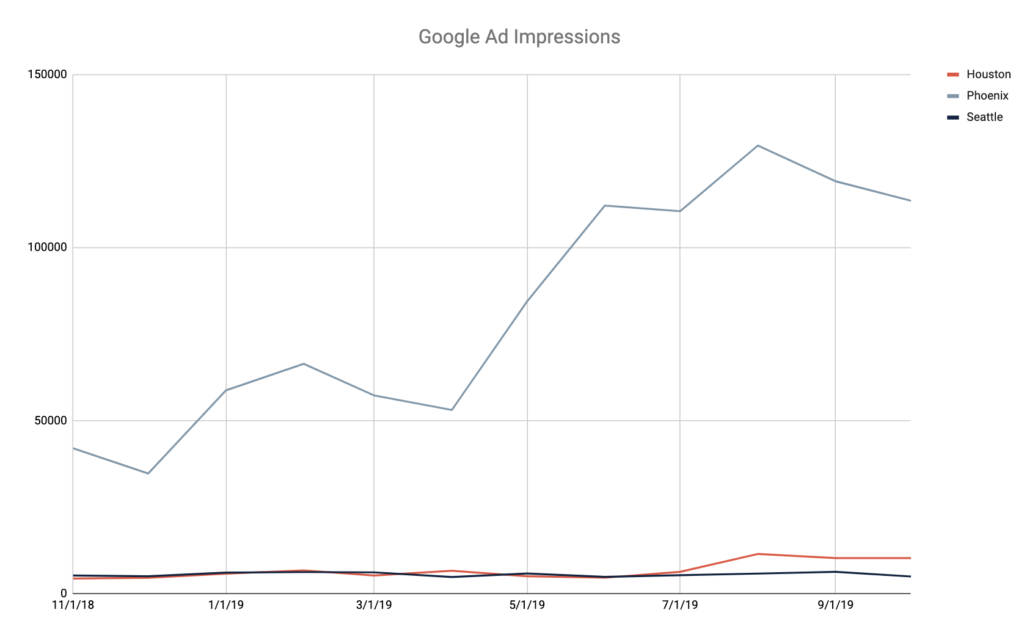
Ad impressions, or how often an ad appears on the Google network for direct or contextually relevant searches, align to the discovery phase of the journey, when renters are passively searching for an apartment. The volume of impressions was much greater in the Phoenix market, but increased dramatically in the summer months. Whereas, in both Houston and Seattle, ad impressions remained steady throughout the year, signaling that renters searched throughout the year for apartments.
Google Ads Clicks
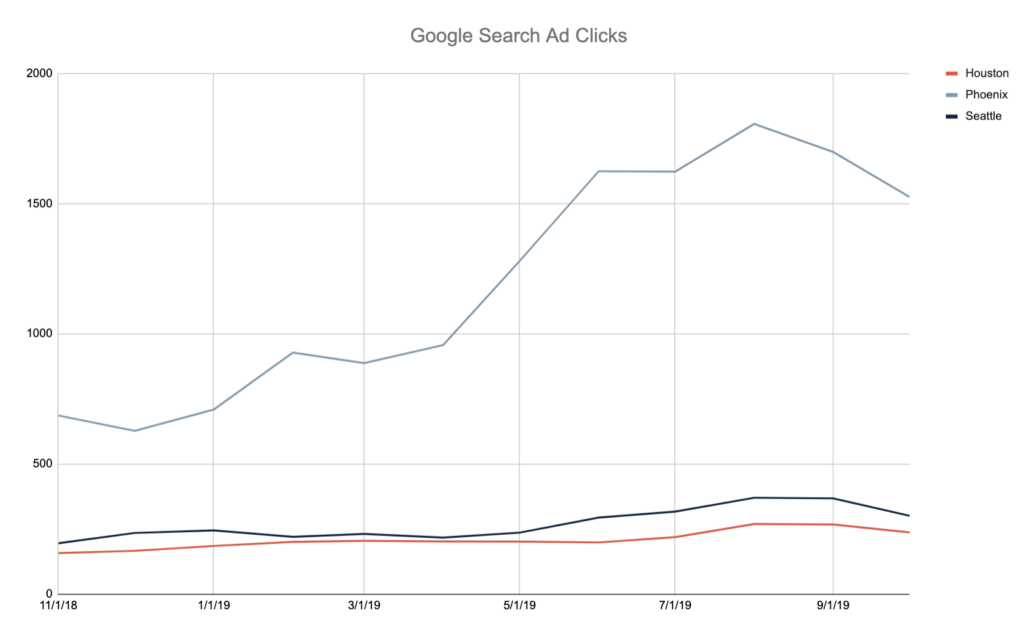
Ad clicks correlate to a more defined interest in an apartment home. Often considered the education phase, this is when renters are actively researching. Across all markets, renters’ interest increased in the summer months.
Website Sessions
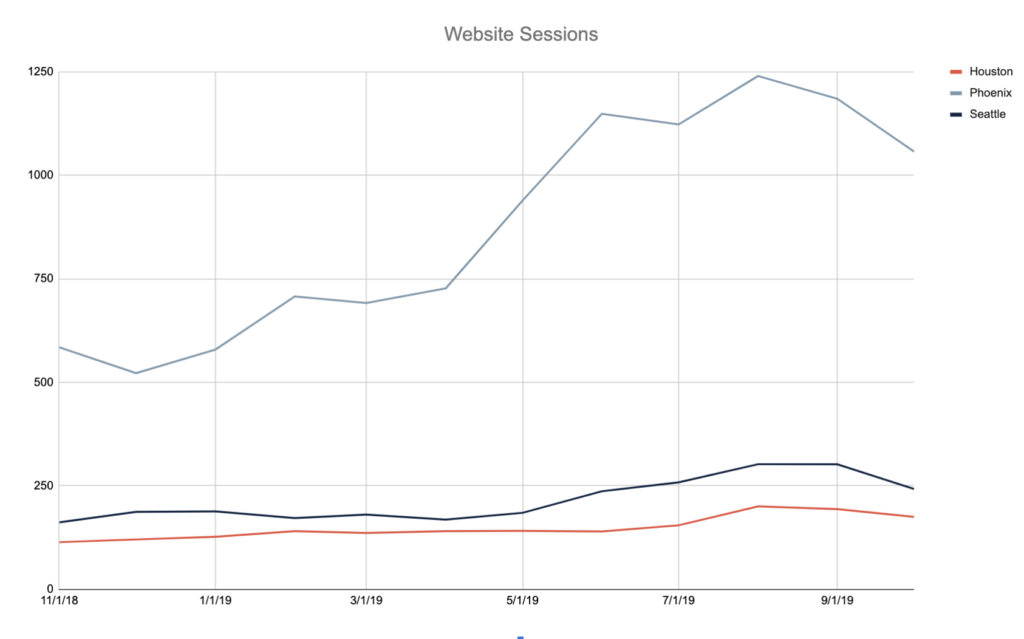
Website sessions also occur during the research phase, but the traffic is better qualified, which signals an active interest. Each market saw increased activity during the summer months, with website sessions in Phoenix rising sharply in the spring.
Multi Touch Attribution Conversions
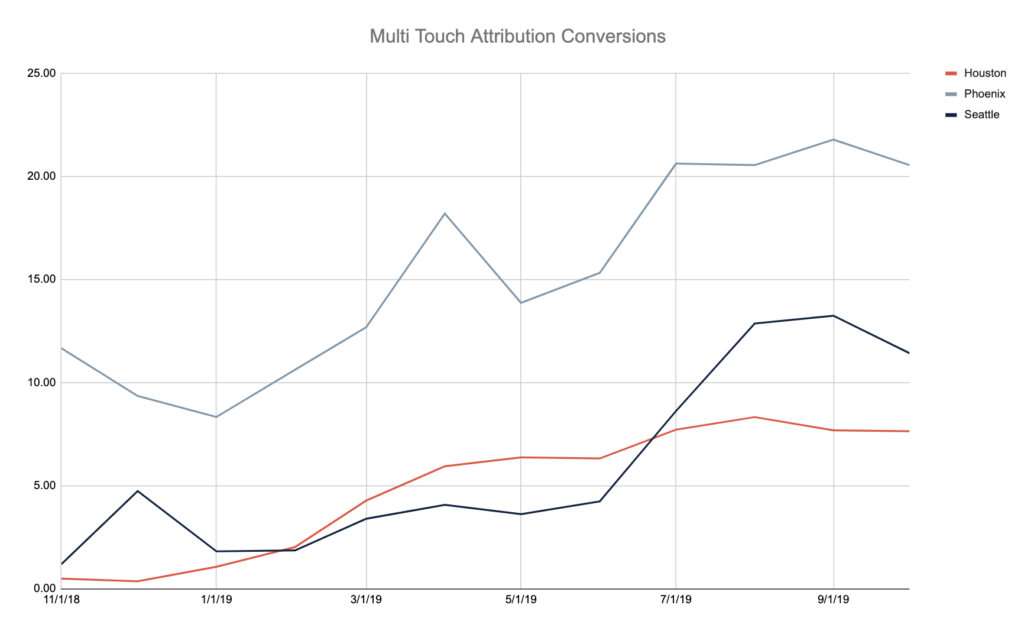
Multi-Touch Attribution (MTA) Conversions, the final KPI we evaluated, uses an advanced attribution model to quantify which marketing channels led to the most form fills, phone calls, tours, or leases during a given time period. Whereas most KPIs represent volume or static conversion rates, the MTA conversion is created by considering each recorded interaction across all users and marketing sources. This metric provides insight into the total renter journey. It helps marketers understand how and when renters are ramping up their search online for a new apartment.
Houston: The Season Starts Early
Although leasing season in Houston does not hit high gear until July, there is an uptick in apartment rentals and inquiries as early as April, when renters who are leaving are required to give a 60-day notice. Interestingly, website sessions do not dip throughout the year. They remain relatively consistent, signaling that renters are regularly researching their next home. Ad impressions and clicks start to increase in July and remain high through the end of the year. The growth in MTA conversions begins in February and continues through August, indicating that renters begin their apartment search ahead of giving notice and continue through the leasing season.
Phoenix: Leasing Season Peaks Twice
In Phoenix, a longer leasing season actually sees online renting behavior peak twice — in April and late summer. The first wave of renters enters the market during tax return season and the second, much larger wave lasts from July through October. The high volume of ad impressions, clicks, and website sessions parallels employment growth and net migration gains to the region.
Seattle: Summer Rush in Renting
Seattle’s peak leasing season coincides with the region’s warmest temperatures and fewest days of rain. Renters in this market actively begin their outreach to properties in August, during the peak leasing season in this area. Renters research apartments consistently throughout the year. Still, the MTA conversion data indicate that renters enter the search rapidly, beginning in June.
Reach Renters at the Right Time
If we assume that renters in all markets search in exactly the same way at the same time, then we miss an opportunity to reach prospective renters when they are most engaged in their search. This is an important blindspot for multifamily marketers: assuming that data is the same across all markets, and that renter behaviors don’t vary. Spending too early or too late on advertising can mean that properties are missing out on renters who begin their apartment search at different times of the year.
Having a deeper understanding of leasing season is important for properties trying to fill vacancies. It allows marketers to align digital advertising spend to the time periods where it will have the greatest impact on the renter’s journey. Advertising efforts from past months continue to deliver conversions many months later when you might have already discounted the impact.
Smart Digital Advertising
G5 Smart Digital Advertising uses an advanced attribution model to predict where to spend your next ad dollar to maximize conversions. This technology evaluates campaign performance nightly and automatically allocates spend across networks and channels to achieve the best return. Unlike traditional digital advertising that relies solely on individual people to manage campaigns, run A/B tests, and allocate spend, Smart Digital Advertising leverages automation, advanced attribution modeling, and machine learning to drive 2.5X more conversions than the real estate industry average.
Smart Digital Advertising isn’t your average digital advertising product – it’s a full solution. We help you attract and convert renters at every stage in their buying journey.
To learn more:
- Download the 1H 2020 Multifamily State of the Industry report
- Schedule a demo
Get News, Articles & Updates in Your Inbox
Thank You for Your Interest
We will be in contact soon and look forward to learning more about you and your company. Based on your marketing challenges, we’ll discuss increasing visibility into your analytics and how to generate more and better leads so you can achieve your marketing goals.
In the meantime, we invite you to check out our checklist on website accessibility. Use this checklist to start assessing the baseline accessibility of your website.
Enjoy! We’ll be in touch very soon.
